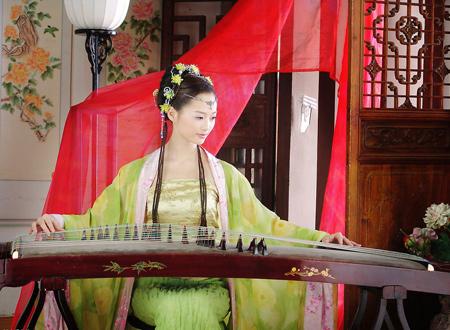


Guqin: The earliest known member of the zither family, the guqin is at least 3,000 years old. The sanxian was a favorite of Puyi, the last emperor of China, whose family commissioned a collection of court music for it. Sanxian: This three-stringed fretless lute, also called the Chinese banjo, was developed approximately 2,500 years ago as part of northern Chinese folk music. Originally a folk instrument of the Dai, one of China’s 55 minority ethnic groups, the hulusi figures prominently in a traditional fairy tale: a boy and girl are not allowed to see each other, so the boy wins the girl’s heart by playing beautiful melodies on the hulusi from afar. Hulusi: This set of free-reed pipes features a resonance chamber made of a gourd. Her connections with colleagues at the Central Conservatory of Music in Beijing have helped Carleton obtain these instruments at reasonable prices. “Your instrument is part of your identity as a musician,” says Gao Hong, whose own pipa is carved with a peony because she was born in Luoyang, which is famous for its Peony Festival. Many of the instruments in the collection feature decoration, such as carving or inlay. “We have the largest collection of Chinese instruments of any American school,” says Gao Hong, who is a lecturer in Carleton’s music department. Carleton’s Chinese Music Ensemble has played in venues around the United States, and last winter, four students won medals at the Huain Cup International Chinese Instrument Competition in San Jose, California.
Ancient chinese music instruments professional#
Treasures on display include a bone flute excavated at a Neolithic site at Jiahu in Henan Province, a set of bronze chime bells from the tomb of Chai Hou (late Spring and Autumn Period), and the process of making a zither.Īll these reveal a picture of the evolution of ancient Chinese musical instruments and convey the cultural values of traditional Chinese music in promoting moral well-being, cultivating individual taste and entertaining the people.A professional pipa player since age 12, Gao Hong teaches Carleton students to play a variety of traditional Chinese instruments. This exhibition contains more than 200 precious musical instruments. In the following dynasties, (AD 265-960) that followed, musical instruments coming from other cultures were widely introduced. Meanwhile, plucked string instruments like the qin and se zithers were popular among the literati of refined taste. As musical instruments are the medium through which music is played and performed, tracing their historical development can help us to reveal the history of music and the history of society in general.Īs Chinese civilization started, there were wind instruments like the flute and whistle and percussion instruments like the bell and drum.įrom the earliest dynasties until the Han Dynasty (202 BC-AD 220), the established system of rituals and music led to the creation of sophisticated musical instruments, which are exemplified by sets of grand chimes (zhong) and chime stones (qing). Music has always played significant roles in facilitating the progress of civilization, promoting exchanges and mutual learning, as well as enriching intellectual and cultural activities. Ever since the ancient time, Chinese people had the saying that "when words fail, music speaks".


 0 kommentar(er)
0 kommentar(er)
